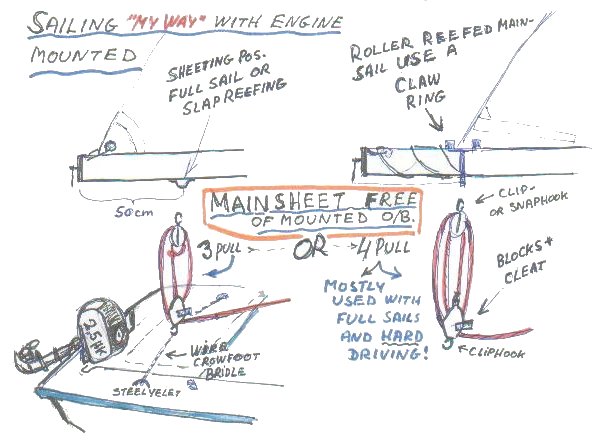| Subject: Ken Jensen talks goosenecks,
engine/mainsheet snarl avoidance, and landing/leaving in surf/rollers -----
Original Message -----
From:
KEN/K.H.Jensen
To:
Dick Rich. C. Harrington ; Allan+W7556
Sue Parry ; Al Uncle Schönborn ; Ralph M Roberts ; bills@rrmodelcraftsman.com
; moseley@DNTechInc.com
; jfraserdar@hotmail.com
Sent:
Thursday, March 25, 2004 2:31 PM
Subject:
W.Cruising
WAYFARER Cruising
(often single-handed - 'My Way' ):
This topic is a never ending
one, and since we are all different, there shall allways be different
solutions. What is brought forward by me has been given to
me along the way from someone there as well as from my own chest.
The burden of age is claimed to be an insult, and it defenitely demands
no waste of energy, when you reach my age, but then again the stimulus
of W.cruising is a marvellous vitamin.
The advantage of gaining
experience - through sailing, performing, doing it - is that
learned tricks/techniques integrate with the personality, and thus
become less technical, and more like "playing by ear/sound/feeling"
being part of a 'SYMPHONY'/ SYM-BIOSIS. In W.Cruising, and
especially solo such proper seamanship is unavoidable!
Gooseneck the
adjustable one gives more working space under the boom with a reefed
mainsail, and a lifted boom is less prone to catch the water in 'rock
and roll'. Full up position on the mast of the sliding gooseneck
is where it's placed for W1348's boomtent, and this is also where it -
with the boom connected and its aft end slanted against the forward
part of the deck-side transom - will hold the mast up - as a strut
support!
Avoiding conflict engine
and mainsheet. A Span/Bridle/Crowfoot is made of
a thin steelwire, extending across-ship from steel-eylet to
steeleylet (over the lid of the aft compartment)
and fastened by a small shackle on either
side, and has a cringle at the midpoint for the mainsheet block's
lower snap- or cliphook. The upper mainsheet block's snap- or cliphook
is hooked to a 'popped' on eye (50cm forward of the boom-end) on
the lower part of the boom, or to - when the roller-reefed
mainsail covers this eye - to a claw ring (called a 'lyre' by us).
 This arrangement prevents
snarling the mainsheet around the mounted engine, which I normally
will prefer removed and stowed, but certain
situations (sudden high wind velocity after calm/flukey
conditions, navigating a strong current into windshelter -
privileged to have looked up at W1348-sails on the way
into *Saltstraumen*, claimed to be the world's strongest seawater
whirlpool and maelstrom, at Bodø, lat. 67*14' N, where we
arrived a bit early, lost the wind due to the terrain and had no
engine!). It's easier, safer, quicker for the solo-sailor to reef down, rearrange the
mainsheet and leave the engine in position at the transom where it
will be easily available.
The 'crowfoot' mentioned above
can be replaced by a prestrecthed synthetic line with a tied eye on the
midpoint, and the ends lead with double-hitches through the
multi-purpose steeleylets to the equal cleats - either
side of the sidedecks (see the earlier sketch of cockpit lay-out).
Landing through rollers and breakers where
drogue
and anchor can be used, but I have no experience of serious/heavy
condition for which Capt. Voss used a drogue with a trip-line and even
demonstrated crossing dangerous bars that way! I have
wondered if
it's possible to back in that way, and hopefully avoid some waterspray
using the sprayhood. Anyway the W. should be hauled out with the
transom first.
Starting to sail out through breakers
is quite interesting, and an anchor left out there about 100-150ft
off is helpful for the start. Be very careful if the boat is
bounching about before you board - it may easily break a leg!
Water at least 3/4 - 1 m I believe is necessary, starting with punting
and oar-steering.
Best W.regards to you all, Ken
|